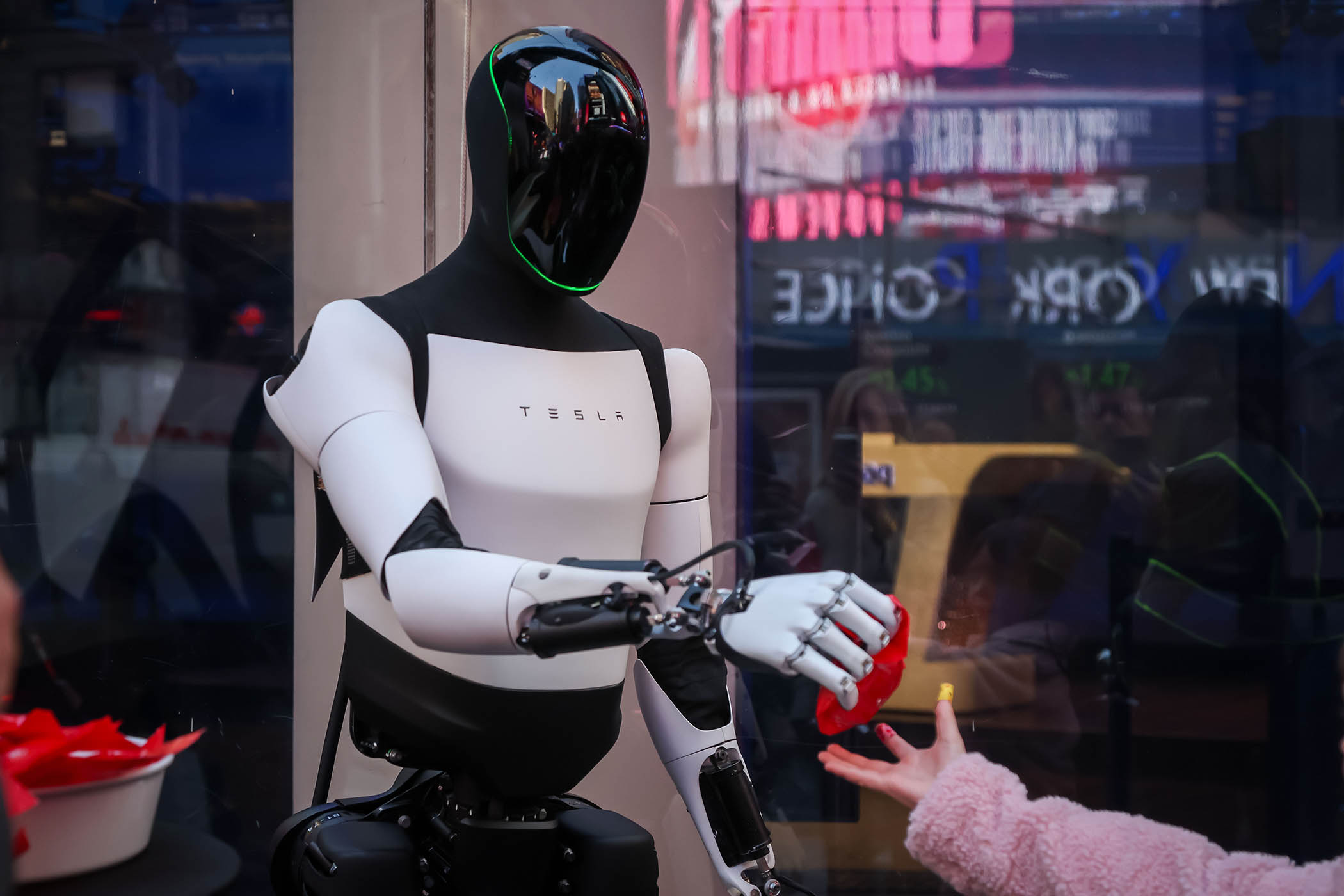At the same investor event at which Musk secured a pay deal worth a potential trillion dollars, he made extravagant promises for Optimus’s potential. “I think it’s going to get to one hundred million a year, maybe even a billion a year,” he said of production numbers, before continuing on its broader potential. “And, you know, people often talk about, like, eliminating poverty, giving everyone amazing medical care. Well, there’s actually only one way to do that, and that’s with the Optimus robot.”
Musk went on to claim that Optimus might also go to the moon, abolish the need for prisons by following convicted criminals in their everyday lives – and more. The concrete goals set for Musk by his board, though, are somewhat more modest: one of the conditions for Musk to secure his unprecedented pay packet is to sell one million (not one billion) robots in the next decade.
Both Musk and Tesla are vague about the target market and tasks for the Optimus robots. Musk has instead set an ambitious price point for the device, of $20,000 (£15,000), and claimed its target market is, in effect, everyone – including home consumers, factories and other business users.
Tesla is actually fairly late to the race of electric car manufacturers now pivoting into humanoid robots. Chinese automaker BYD, alongside other Chinese firms such as Huawei and Xiaomi, has ploughed major research and development budgets into androids, but experts suggest they are defining their market and uses more tightly than Tesla.
“Most Chinese players are pursuing near-term, narrowly defined use cases where repetitive tasks can be structured and the return on investment is clear,” explained Bill Russo, a former Chrysler executive and the CEO of Shanghai-based consultancy Automobility. These markets include factory logistics, warehousing, retail roles “in standardised environments”, and potentially elder care, albeit in the longer term.
“Most Chinese firms are aiming for commercial pilots in 2025-26, with meaningful scale not before 2028 or 2030,” he concludes. “Their view of market size aligns with the broader robotics consensus: tens of billions of dollars in the early 2030s if reliability, cost and autonomy improve in line with expectations.”
Several industry experts drew a sharp contract between the relatively modest expectations of Chinese firms versus Tesla’s vision.
“Tesla’s vision, as with many of Musk’s initiatives, is much more expansive. The Optimus narrative is explicitly consumer-oriented – ‘an Optimus in every home’,” explains Rui Ma, creator of Tech Buzz China, a newsletter for investors. “Chinese companies, on the other hand, are typically more practical. Many of the better funded are focused on industrial applications, which are both more near-term realistic and easier to define.”
Ma, however, credits Tesla with “dramatically expanding the imagination of the sector” and accelerating global interest in humanoid robots, while Russo noted that Tesla has a measure of advantage through its ability to test robots in its own facilities, even if its public-facing plans are ambitious and somewhat lacking in detail.
Tu Le, the founder of Sino Auto Insights, believes Tesla is moving relatively slowly versus its Chinese rivals, who are in his view much closer to bringing a product to market. He also questioned whether US lawmakers might slow progress. “Countries with strong labour laws would likely want to regulate the usage of humanoids too so even if the tech were there, the policies might not be,” he said.
There is no question that Musk will push Tesla to build the million robots, but what will those robots be exactly?
Edward Niedermeyer, author
Edward Niedermeyer, author of Ludicrous: The Unvarnished Story of Tesla Motors and a prominent Tesla sceptic, said it was worth viewing Musk’s extravagant promises for Optimus in the context of previous grand promises, such as on full self-driving, that were not delivered.
“Asking about his pay package is the right question here. Elon shoots for the stars, almost always misses, and yet always seems to land on the moon all by himself, metaphorically speaking,” he said. “There is no question that he will push Tesla to build the million robots he needs to hit his pay target, but the question is: what will those robots be exactly?”
Niedermeyer noted that one demonstrated version of Optimus could run an large language model, walk and run, but had mannequin hands, while another model demonstrated at the launch of the Tron: Ares movie had moveable hands but only seemed to be capable of “rehearsed action”. Given these disparate models exist, and that Musk has already talked about Optimus 2, 3 and even 4, there might be multiple models for die-hard fans to buy.
“He’s a showman, and the show is the point,” Niedermeyer concludes. “Eventually, with enough versions of this, he’ll scrape a million sales out of his most devoted dimwit fans, mostly by reselling to the same people over and over again.”
Absent a more targeted set of features, and a clearer target consumer, sceptics might assume Optimus is just another inflated claim from Elon Musk, a man who promised full self-driving cars by 2016 and promised he’d send a rocket to Mars by 2018, with a manned mission by 2024.
Those with a more generous view of Musk might note that even if he didn’t deliver on these promises, he did develop the world’s most sophisticated rockets and a global network of Starlink satellites over that time. But looking at Tesla’s Chinese rivals, it seems hard to doubt that humanoid robots, in one form or another, are coming in the next few years – whether or not it’s Elon Musk who delivers them.
Photograph by Michael Nagle/Bloomberg via Getty
